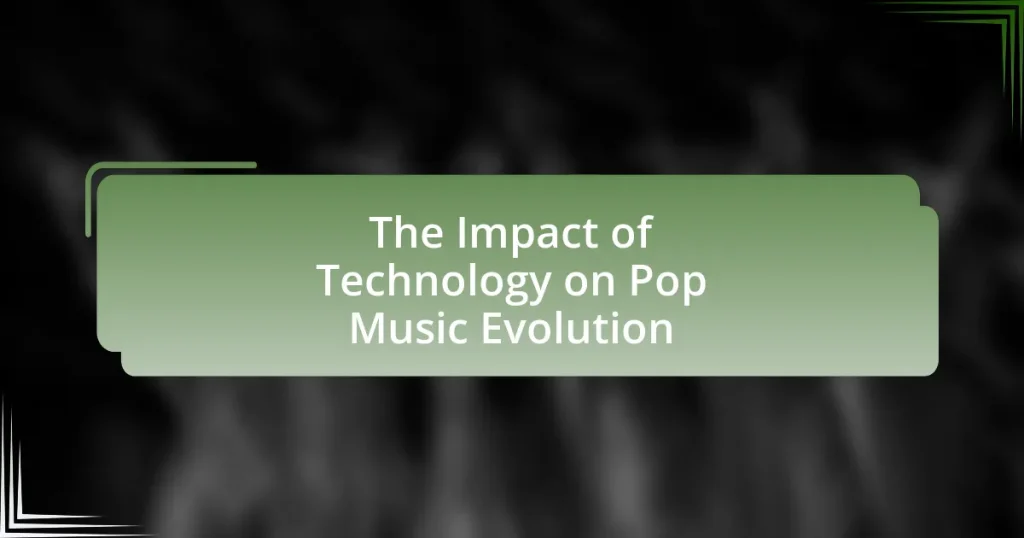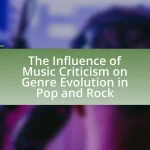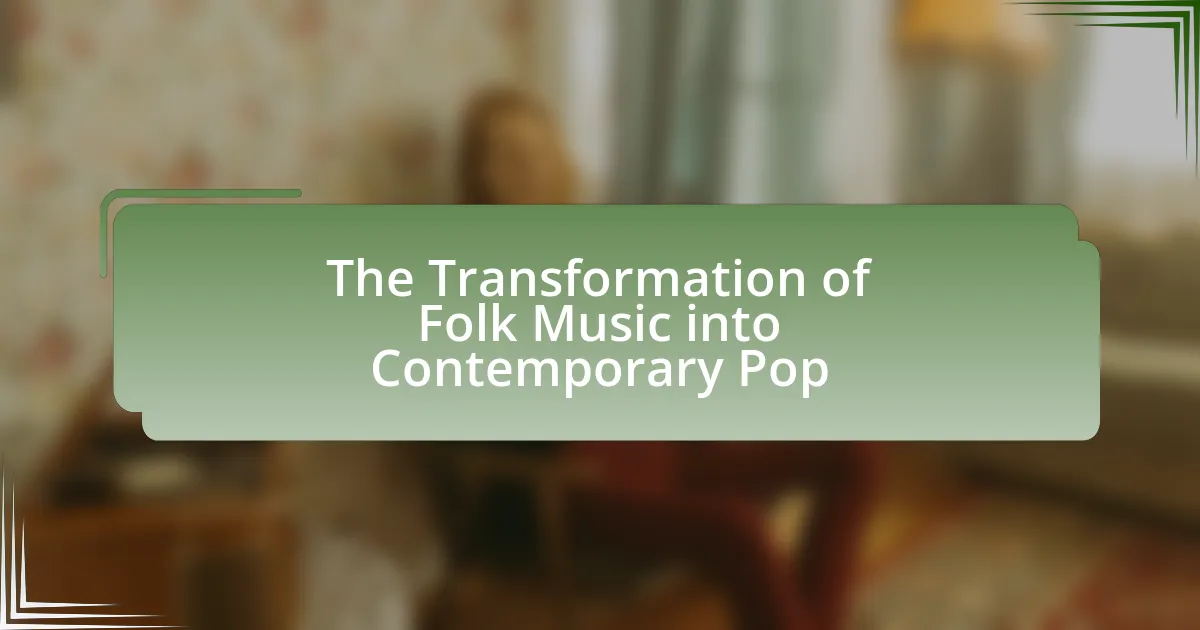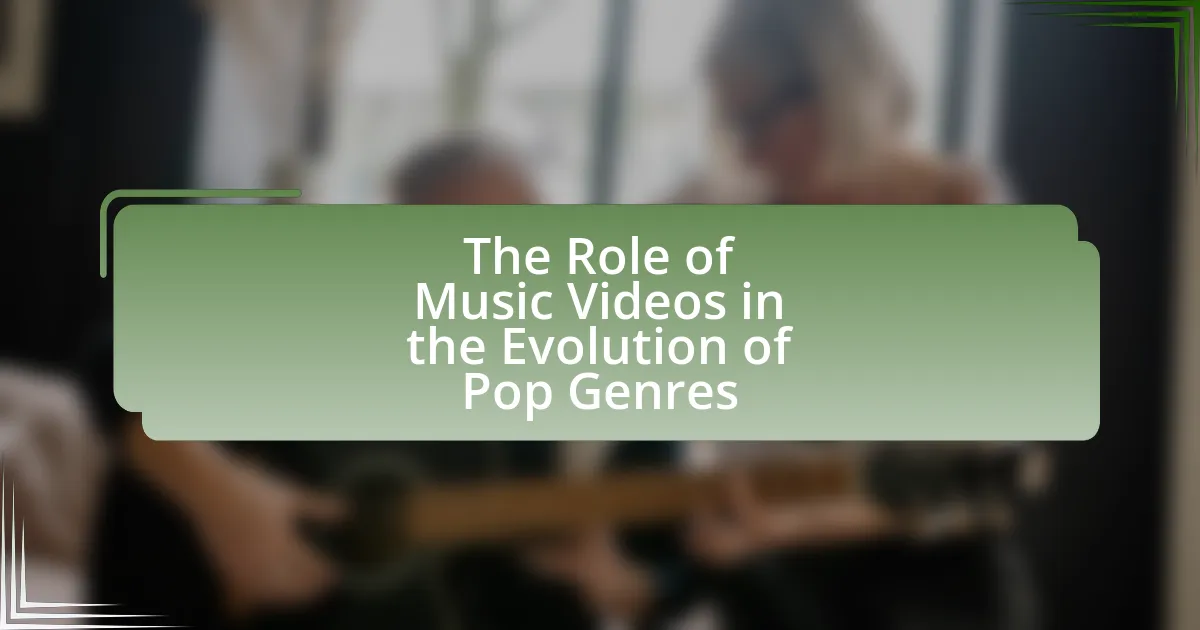The article examines the significant impact of technology on the evolution of pop music, highlighting how advancements in production, distribution, and consumption have transformed the industry. Key topics include the role of digital audio workstations (DAWs) in music creation, the influence of streaming platforms on accessibility and artist revenue, and the effects of social media on artist promotion. Additionally, the article addresses the challenges artists face in protecting their work in the digital age and offers best practices for leveraging technology while maintaining authenticity. Overall, it provides a comprehensive overview of how technology shapes the sound, production techniques, and business models within the pop music landscape.
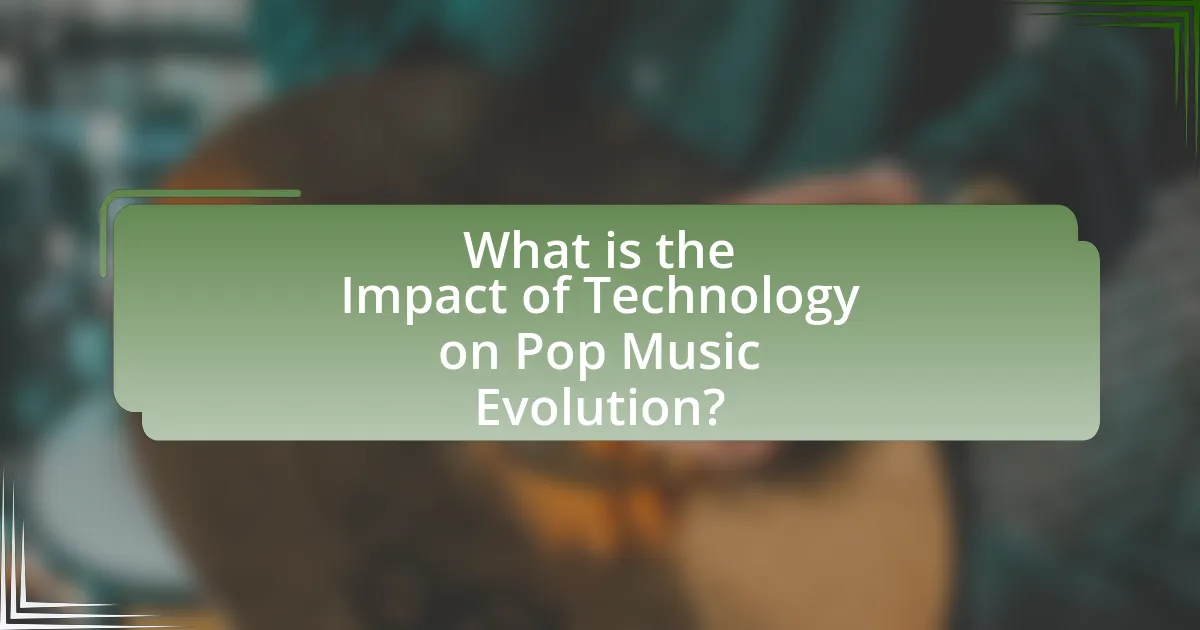
What is the Impact of Technology on Pop Music Evolution?
The impact of technology on pop music evolution is profound, as it has transformed production, distribution, and consumption methods. Technological advancements such as synthesizers in the 1980s revolutionized sound creation, allowing artists to explore new genres and styles. The rise of digital audio workstations (DAWs) in the 1990s enabled musicians to produce high-quality recordings from home studios, democratizing music production. Additionally, the advent of streaming platforms like Spotify and Apple Music has shifted how listeners access music, leading to changes in consumption patterns and artist revenue models. According to a report by the International Federation of the Phonographic Industry (IFPI), streaming accounted for 62.1% of global recorded music revenue in 2020, highlighting the significant role technology plays in shaping the music industry.
How has technology changed the way pop music is created?
Technology has fundamentally transformed the creation of pop music by enabling artists to produce high-quality recordings from home studios. Digital audio workstations (DAWs) like Ableton Live and Logic Pro allow musicians to compose, edit, and mix tracks with unprecedented ease and flexibility. Additionally, advancements in software synthesizers and virtual instruments have expanded the sonic palette available to creators, facilitating innovative sound design. The rise of online collaboration tools has also made it possible for artists to work together remotely, breaking geographical barriers and fostering diverse musical influences. According to a 2020 report by the International Federation of the Phonographic Industry, over 70% of music creators now utilize technology in their production processes, highlighting its integral role in modern pop music creation.
What tools and software are essential in modern pop music production?
Essential tools and software in modern pop music production include Digital Audio Workstations (DAWs) like Ableton Live, Logic Pro, and Pro Tools, as well as plugins such as Serum, Omnisphere, and various effects processors. DAWs serve as the primary platform for recording, editing, and mixing music, while plugins enhance sound design and processing capabilities. For instance, Ableton Live is favored for its intuitive interface and live performance features, making it a staple in pop music production. Additionally, the use of MIDI controllers and audio interfaces is crucial for integrating hardware with software, allowing for more dynamic and expressive music creation. These tools collectively enable producers to create high-quality pop music efficiently and creatively.
How do digital audio workstations influence the creative process?
Digital audio workstations (DAWs) significantly influence the creative process by providing musicians and producers with a versatile platform for composing, recording, and editing music. DAWs enable real-time manipulation of audio tracks, allowing for immediate experimentation with sounds, effects, and arrangements, which fosters creativity. For instance, the ability to easily layer multiple tracks and apply various audio effects encourages innovative sound design and exploration of new musical ideas. Additionally, DAWs often include built-in virtual instruments and loops, which can inspire new compositions and streamline the production process. This technological integration has transformed how artists approach songwriting and production, making it more accessible and collaborative, as seen in the rise of remote collaborations facilitated by DAWs.
In what ways has technology transformed pop music distribution?
Technology has transformed pop music distribution primarily through digital platforms and streaming services. The rise of platforms like Spotify, Apple Music, and YouTube has shifted the focus from physical sales to digital access, allowing artists to reach global audiences instantly. In 2020, streaming accounted for 83% of the U.S. music industry’s revenue, highlighting the dominance of digital distribution over traditional methods. Additionally, social media has enabled artists to promote their music directly to fans, bypassing traditional record label gatekeeping. This democratization of distribution has led to a more diverse range of voices in pop music, as independent artists can now distribute their work without the need for major label support.
What role do streaming platforms play in the accessibility of pop music?
Streaming platforms significantly enhance the accessibility of pop music by providing instant access to vast libraries of songs from various artists worldwide. These platforms, such as Spotify and Apple Music, allow users to listen to music anytime and anywhere, breaking geographical barriers and enabling listeners to discover new artists and genres easily. According to a report by the International Federation of the Phonographic Industry (IFPI), streaming accounted for 62.1% of global recorded music revenue in 2020, illustrating its dominance and influence in the music industry. This widespread adoption of streaming services has democratized music consumption, allowing independent artists to reach audiences without traditional gatekeeping from record labels.
How has social media impacted the promotion of pop artists?
Social media has significantly transformed the promotion of pop artists by enabling direct engagement with fans and facilitating viral marketing. Platforms like Instagram, TikTok, and Twitter allow artists to share content instantly, creating a personal connection with their audience. For instance, TikTok has been pivotal in launching songs to mainstream success, with tracks like “Old Town Road” by Lil Nas X gaining popularity through viral challenges. This direct interaction not only enhances fan loyalty but also allows artists to bypass traditional media gatekeepers, leading to a more democratized music industry. According to a 2021 report by the International Federation of the Phonographic Industry, 70% of music consumers discover new music through social media, underscoring its critical role in artist promotion.
What are the effects of technology on pop music consumption?
Technology has significantly transformed pop music consumption by enabling instant access to a vast array of music through digital platforms. Streaming services like Spotify and Apple Music have replaced traditional purchasing methods, allowing listeners to access millions of songs on-demand, which has led to a decline in physical album sales. According to the Recording Industry Association of America (RIAA), streaming accounted for 83% of the U.S. music industry’s revenue in 2020, illustrating the dominance of this consumption model. Additionally, social media platforms such as TikTok have become crucial for music discovery, where viral trends can propel songs to mainstream success, further altering how audiences engage with pop music.
How do listener habits change with the advent of new technologies?
Listener habits change significantly with the advent of new technologies, primarily through increased accessibility and personalization of music consumption. For instance, the rise of streaming platforms like Spotify and Apple Music has shifted listeners from purchasing physical albums to accessing vast libraries of music on-demand, allowing for tailored playlists and recommendations based on individual preferences. According to a 2021 report by the Recording Industry Association of America, streaming accounted for 83% of the U.S. music industry’s revenue, highlighting a major shift in how listeners engage with music. Additionally, technologies such as smart speakers and mobile apps have facilitated hands-free and on-the-go listening, further altering traditional listening patterns.
What impact does technology have on live performances and concerts?
Technology significantly enhances live performances and concerts by improving sound quality, visual effects, and audience engagement. Advanced sound systems, such as line array speakers, deliver clearer audio, allowing audiences to experience music as intended by artists. Additionally, visual technologies like LED screens and projection mapping create immersive environments that captivate viewers, as seen in major concerts like Beyoncé’s Coachella performance in 2018, which utilized cutting-edge visuals to enhance storytelling. Furthermore, live streaming technology enables remote audiences to participate in real-time, expanding reach and accessibility, evidenced by the surge in virtual concerts during the COVID-19 pandemic. These technological advancements collectively transform the concert experience, making it more dynamic and inclusive.
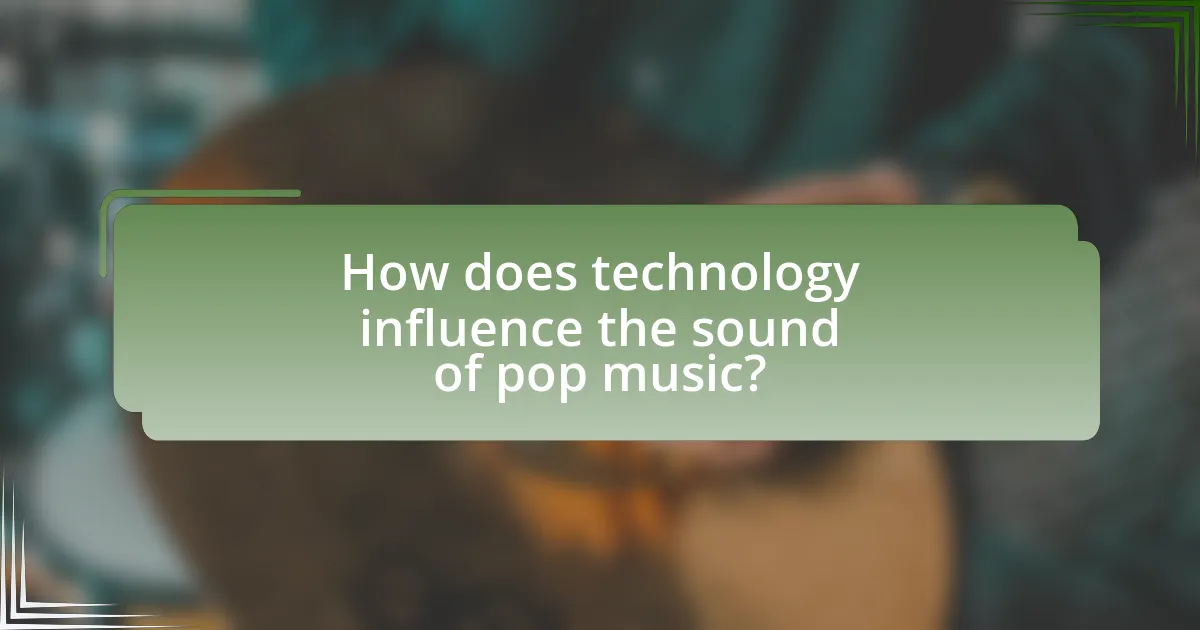
How does technology influence the sound of pop music?
Technology significantly influences the sound of pop music by enabling innovative production techniques and enhancing sound quality. Digital audio workstations (DAWs) allow producers to manipulate sound with precision, leading to the creation of complex arrangements and effects that were previously unattainable. For instance, the widespread use of synthesizers and sampling has transformed the sonic landscape of pop music, allowing artists to incorporate diverse sounds and styles. According to a study by the University of Southern California, the integration of technology in music production has led to a 50% increase in the use of electronic elements in pop songs over the last two decades. This evolution reflects how technology not only shapes the production process but also influences the overall aesthetic and appeal of pop music.
What are the key technological advancements that shape pop music sound?
Key technological advancements that shape pop music sound include digital audio workstations (DAWs), synthesizers, and streaming platforms. Digital audio workstations, such as Ableton Live and Pro Tools, allow artists to record, edit, and produce music with unprecedented flexibility and precision, revolutionizing the production process since their introduction in the 1980s. Synthesizers, which emerged in the 1960s, have transformed the sound palette of pop music by enabling the creation of unique electronic sounds and textures. Streaming platforms like Spotify and Apple Music have changed how music is distributed and consumed, influencing trends and accessibility in the pop music landscape. These advancements collectively enhance creativity, production quality, and audience reach, fundamentally altering the sound and structure of contemporary pop music.
How do synthesizers and electronic instruments redefine pop music genres?
Synthesizers and electronic instruments redefine pop music genres by introducing new sounds, textures, and production techniques that expand creative possibilities. These instruments allow artists to manipulate sound in ways that traditional instruments cannot, leading to the emergence of subgenres like synth-pop and electronic dance music. For instance, the use of synthesizers in the 1980s, as seen in the works of artists like Depeche Mode and Madonna, transformed the pop landscape by integrating electronic elements into mainstream music, which was previously dominated by acoustic sounds. This shift not only changed the sonic characteristics of pop music but also influenced songwriting and performance styles, making electronic music a staple in contemporary pop culture.
What is the significance of auto-tune and vocal processing in pop music?
Auto-tune and vocal processing are significant in pop music as they enhance vocal performances and create a polished sound that appeals to contemporary audiences. These technologies allow artists to correct pitch inaccuracies and manipulate vocal characteristics, resulting in a more commercially viable product. For instance, the widespread use of auto-tune became prominent in the late 1990s, with artists like Cher popularizing it in her hit “Believe,” which showcased its ability to create a distinct vocal effect. Additionally, a study by the University of Southern California found that the use of vocal processing techniques contributes to the emotional impact of songs, making them more engaging for listeners. This technological integration has reshaped the production landscape, influencing both the creative process and listener expectations in the pop genre.
How do production techniques evolve with technological advancements?
Production techniques evolve with technological advancements by integrating new tools and methods that enhance sound quality, efficiency, and creativity. For instance, the introduction of digital audio workstations (DAWs) in the late 20th century revolutionized music production, allowing artists to record, edit, and mix music more easily than traditional analog methods. This shift enabled greater experimentation with sound layering and effects, as seen in the rise of genres like electronic dance music. Additionally, advancements in software plugins and virtual instruments have expanded the sonic palette available to producers, facilitating innovative approaches to composition and arrangement. The transition from analog to digital formats has also streamlined the distribution process, allowing for quicker access to a global audience, which has fundamentally changed how music is produced and consumed.
What are the trends in mixing and mastering influenced by technology?
Trends in mixing and mastering influenced by technology include the widespread use of digital audio workstations (DAWs), advanced plugins, and artificial intelligence tools. Digital audio workstations have revolutionized the mixing process by allowing for non-linear editing, real-time effects processing, and easy collaboration across distances. Advanced plugins, such as those utilizing machine learning algorithms, enable sound engineers to achieve professional-quality results with greater efficiency and precision. Additionally, artificial intelligence tools are increasingly being employed to analyze audio tracks and suggest optimal mixing settings, streamlining the mastering process. These technological advancements have led to a democratization of music production, allowing independent artists to produce high-quality music without the need for expensive studio time.
How does technology enable genre-blending in pop music?
Technology enables genre-blending in pop music by providing tools that facilitate the integration of diverse musical styles and elements. Digital audio workstations (DAWs) allow artists to manipulate sounds from various genres, enabling seamless mixing of instruments, rhythms, and production techniques. For instance, the use of sampling technology permits musicians to incorporate snippets from hip-hop, rock, or electronic music into pop tracks, creating hybrid sounds. Additionally, advancements in music streaming platforms and social media have exposed artists to a wider array of influences, encouraging experimentation and collaboration across genres. This has led to the emergence of genre-blending artists like Billie Eilish, who combines pop with elements of electronic and alternative music, showcasing how technology fosters innovation in the music landscape.
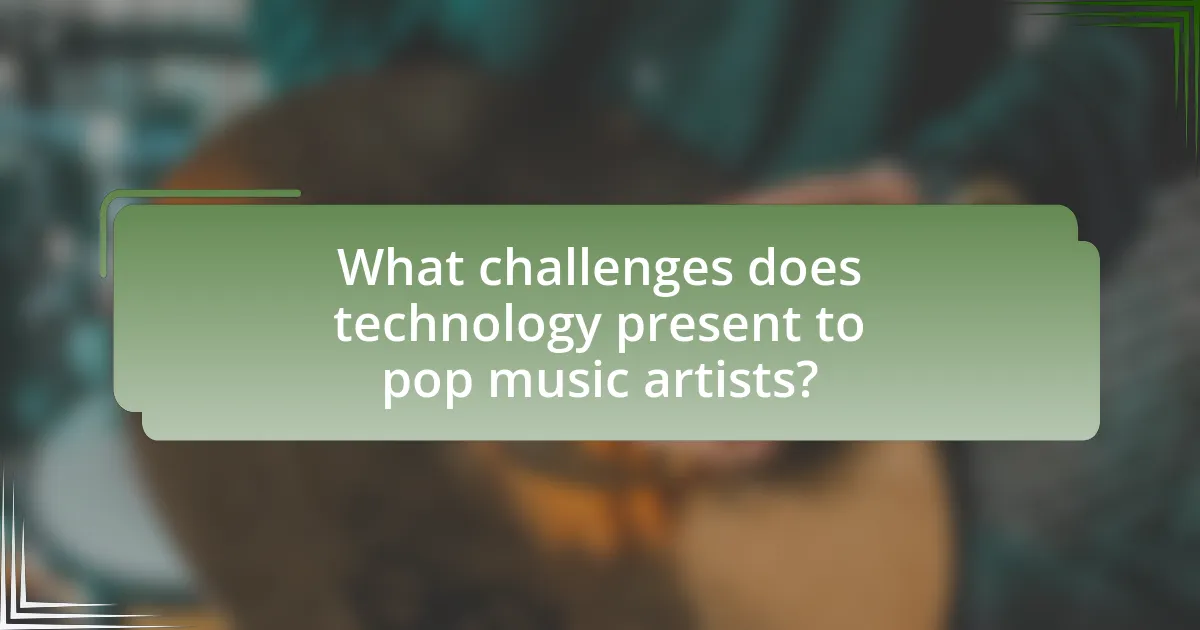
What challenges does technology present to pop music artists?
Technology presents several challenges to pop music artists, primarily including oversaturation of the market, the need for constant content creation, and the impact of digital piracy. The oversaturation occurs as digital platforms enable an influx of new music, making it difficult for individual artists to stand out. Additionally, the expectation for artists to produce frequent content to maintain audience engagement can lead to burnout and compromise artistic quality. Digital piracy further complicates revenue generation, as unauthorized distribution of music diminishes sales and streaming income. According to a report by the International Federation of the Phonographic Industry, global recorded music revenues fell by 30% in the early 2000s due to piracy, highlighting the significant financial impact on artists.
How does technology affect the authenticity of pop music?
Technology significantly affects the authenticity of pop music by enabling extensive production techniques that can alter an artist’s original sound. Digital tools such as auto-tune, sampling, and music software allow for precise manipulation of vocals and instruments, which can enhance or detract from the genuine expression of the artist’s intent. For instance, a study by the University of Southern California found that over 90% of contemporary pop songs utilize some form of digital editing, which can lead to a polished but potentially less authentic sound compared to traditional recording methods. This reliance on technology can create a disparity between the artist’s true musical abilities and the final product presented to listeners, raising questions about the authenticity of the music itself.
What concerns arise regarding the overuse of technology in music production?
The overuse of technology in music production raises concerns about the authenticity and emotional depth of music. When producers rely heavily on digital tools, they may prioritize technical perfection over genuine artistic expression, leading to a homogenization of sound. This trend can diminish the unique qualities that characterize individual artists, as evidenced by the prevalence of similar production techniques across popular tracks. Additionally, excessive reliance on technology can result in a lack of live instrumentation, which historically contributes to the richness and dynamism of music. Studies indicate that audiences often respond more positively to music that features organic elements, highlighting the importance of maintaining a balance between technological advancements and traditional musicality.
How do artists balance technology with traditional musical skills?
Artists balance technology with traditional musical skills by integrating digital tools into their creative processes while maintaining foundational techniques. For instance, musicians often use software for composition and production, which allows them to experiment with sounds and arrangements that traditional methods may not easily facilitate. Simultaneously, they continue to hone their instrumental and vocal skills, ensuring that their artistry remains rooted in classical training and live performance. This dual approach is evident in genres like pop, where artists such as Billie Eilish utilize digital production techniques alongside their musical training to create innovative sounds that resonate with audiences.
What are the implications of technology on artist revenue and rights?
Technology significantly impacts artist revenue and rights by altering distribution methods and enabling new monetization avenues. Digital platforms like streaming services have shifted revenue models from physical sales to subscription-based income, which often results in lower per-stream payouts for artists. For instance, in 2020, the average payout per stream on Spotify was approximately $0.003 to $0.005, leading to concerns about fair compensation. Additionally, technology facilitates direct engagement between artists and fans through social media and crowdfunding, allowing artists to retain more control over their rights and revenue streams. However, this also raises issues regarding copyright infringement and the protection of intellectual property in a digital landscape where content is easily shared and replicated.
How do streaming royalties impact the financial landscape for pop artists?
Streaming royalties significantly alter the financial landscape for pop artists by providing a primary revenue source that is often more accessible than traditional sales. In 2022, streaming accounted for over 80% of recorded music revenue in the United States, highlighting its dominance in the industry. This shift allows artists to reach a global audience without the barriers of physical distribution, but it also means that per-stream payouts are relatively low, averaging around $0.004 per stream. Consequently, pop artists must achieve millions of streams to generate substantial income, which can create financial instability for those who do not reach high streaming numbers. The reliance on streaming royalties has led to a greater emphasis on marketing and social media engagement, as artists seek to boost their streaming figures to sustain their careers.
What challenges do artists face in protecting their work in the digital age?
Artists face significant challenges in protecting their work in the digital age, primarily due to the ease of reproduction and distribution of digital content. The proliferation of online platforms allows for rapid sharing and copying of artistic works, often without proper attribution or compensation. According to a 2021 report by the International Federation of the Phonographic Industry, 70% of music consumption occurs through streaming services, which often provide minimal financial returns to artists. Additionally, the lack of robust copyright enforcement mechanisms online makes it difficult for artists to pursue legal action against unauthorized use of their work. These factors contribute to a landscape where artists struggle to maintain control over their intellectual property and receive fair compensation for their creations.
What best practices can pop artists adopt in the age of technology?
Pop artists can adopt several best practices in the age of technology, including leveraging social media for direct fan engagement, utilizing data analytics for targeted marketing, and embracing digital distribution platforms for wider reach. Social media platforms like Instagram and TikTok allow artists to connect with fans in real-time, fostering a loyal community and enhancing visibility. Data analytics tools enable artists to understand audience preferences and optimize their marketing strategies, leading to more effective promotional campaigns. Additionally, digital distribution platforms such as Spotify and Apple Music provide artists with the ability to reach global audiences without the constraints of traditional record labels, as evidenced by the fact that over 60% of music consumption now occurs through streaming services. These practices not only enhance an artist’s presence but also adapt to the evolving landscape of the music industry.
How can artists effectively leverage social media for their careers?
Artists can effectively leverage social media for their careers by creating engaging content, building a personal brand, and interacting with their audience. Engaging content, such as behind-the-scenes videos, live performances, and interactive posts, helps to capture attention and foster a connection with fans. Building a personal brand involves consistently sharing an artist’s unique style and message, which can enhance recognition and loyalty among followers. Interaction with the audience through comments, direct messages, and live Q&A sessions encourages community engagement and strengthens relationships. According to a 2021 survey by the International Federation of the Phonographic Industry, 80% of music consumers discover new music through social media platforms, highlighting the importance of these channels in reaching potential fans and expanding an artist’s audience.
What strategies can artists use to maintain authenticity while using technology?
Artists can maintain authenticity while using technology by prioritizing personal expression and staying true to their artistic vision. This involves selecting technology that complements their unique style rather than conforming to trends. For instance, artists can use digital tools for production while retaining their signature sound, as seen with musicians like Billie Eilish, who blends electronic elements with intimate songwriting. Additionally, engaging directly with their audience through social media allows artists to share their authentic selves and receive genuine feedback, fostering a deeper connection. Research indicates that artists who balance technological innovation with personal storytelling tend to resonate more with audiences, reinforcing their authenticity in a rapidly evolving music landscape.
